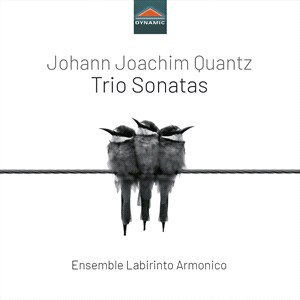
ESSENTIAL RECORDINGS

Trio Sonata in G Major, QV 2:Anh.26 Trio Sonata in G Minor, QV 2:Anh.34 Trio Sonata in C Minor, QV 2:Anh.5 Trio Sonata in G Major, QV 2:Anh.28 Trio Sonata in C Major, QV 2:Anh.3 Trio Sonata in G Major, QV 2:29
If you believe you've experienced all the best there is to hear from the Baroque music period, think again. The music of the unjustly overlooked German flutist and composer Johann Joachim Quantz (1697-1773) deserves a more eminent ranking within his contemporaries, and certainly merits a more prominent presence on stage and in the recording studio. He published an essay titled On Playing the Flute, and his prodigious output includes hundreds of flute concertos and sonatas. He was an actual flute maker as well, an instrument for which he developed innovative designs. His music has been erroneously compared, and hence believed inferior, to the music of Vivaldi. His was music written in the Italian style in vogue at the time, but that is where the similarity ends. Less repetitive and more contrapuntal than Vivaldi's, it certainly calls for a significant reappraisal.
The Trio Sonatas featured in this recording are early works, and skilfully mesh this theatrical Italian style with formal German structure and counterpoint, and in doing so consistently present an intricate and well-balanced sonic canvas. The first and last in G major are presented here as world premiere recordings. The Italian Ensemble Labirinto Armonico, is comprised of Roberto Torto (recorders), Pierluigi Mencattini (baroque violin), Galileo Di Ilio (baroque cello), Sergio Basilico (archlute) and Walter D'Arcangelo (harpsichord). Previous recordings include the music of Telemann, Scarlatti, Corelli, Philidor, etc ... There is a constant sense of ebullience within their delivery of the faster movements, well counterbalanced by highly expressive slow movements. As well, the audio soundscape is finely tuned, with the recorder just slightly forward, and all other instruments clearly audible. The recording took place in the Santi Valentino e Damiano Church in Pescara, Italy, and projects a natural spatial picture.
Previous recordings of this composer's music contain the odd piece here and there, nestled within collections featuring works by various baroque composers. So it's nice to see a full disc devoted exclusively to the music of Johann Joachim Quantz, a 16th century composer well worth discovering.
Jean-Yves Duperron - July 2022